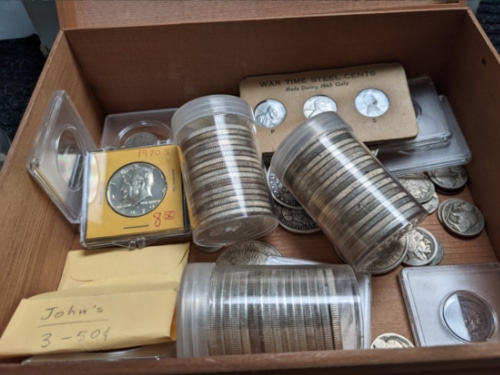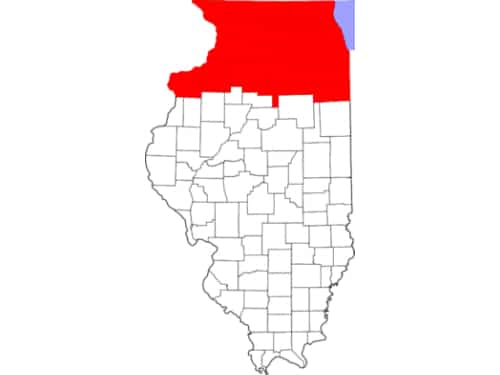Oakton Coins & Collectibles is one of the highest-rated coin shops in all of Illinois.
If you are considering selling your coin collection, you’ve come to the right place.
Oakton Coins and Collectibles understands that selling a single coin or a whole coin collection can be an extremely daunting task. Whether you’re a lifetime coin collector or have recently inherited a coin collection, when it comes time to sell your coins you have many options, and Oakton Coins & Collectibles can simplify the process. Although we’re located in Northern Illinois, many people from Northern Illinois mail us their collections as well. Usually, we communicate via email or texting regarding the appraisal. We always reimburse shipping costs and send you a check very quickly. Many people in Northern Illinois trust us with their valuables because of our track record of discretion and consistently high payments.
Understanding How to Sell Coins around Northern Illinois
When it comes to selling coins, you need to take a lot of factors into account. For instance, your coins could simply be worth face value, or they could be worth a significant amount of money. People don’t only collect valuable coins; often, they collect low-value or face-value coins for other reasons. But no matter the size or value of your collection, we’re here to help.
Sometimes, people sell their whole collection. Other times, they sell the valuable parts and split up the rest between relatives.
Often, people send us their coins carefully arranged by date and decade and placed in separate Ziploc bags or paper envelopes/coin tubes. You might be tempted to do this, but it’s not worth the effort.
When we appraise a collection, the first thing we do is separate coins by their composition (e.g., copper, nickel, silver, or gold). If you feel you must organize your collection, please put it into these groups:
- Gold coins
- 9o% silver dollars (1878 through 1935)
- 9o% silver dimes, quarters, and half dollars (1892 through 1964)
- 40% silver JFK half dollars (1965 through 1970)
- Lincoln wheat cents (1909 through 1958)
- Buffalo nickels (1913 through 1938)
- Jefferson nickels (1938 and later)
- All other obsolete U.S. coins
- U.S. mint proof and uncirculated sets
- U.S. mint commemorative sets
- Currency and paper money
- Foreign coins/tokens
Interesting coins are available for purchase in every budget range, so ask yourself the following questions to help determine your collection’s value:
- Can you determine how much money the collector spent or how regularly the owner bought?
- Can you find any bills of sale, invoices, or canceled checks from dealers or auction firms?
- Do you have an insurance policy or a will with instructions?
This information may be helpful, but you can’t completely depend on any of it. The value of coins (and collectible paper money), like the value of anything else, is what a willing buyer will pay a willing seller. This amount is never a fixed figure, as the market fluctuates in varying degrees and at unpredictable rates.
Pricing Your Collection to Sell around Northern Illinois
Ninety-nine percent of the time, you won’t receive the value listed in any of the pricing guides that you may reference when you sell coins. The guides are simply a way to help you establish the price range you can reasonably expect for a coin. Most consumer guides show extremely inflated values.
Keep these coin-selling terms in mind: clickbait pricing, real-world pricing, melt-value pricing, and numismatics pricing.
Clickbait Pricing: Wikipedia defines “clickbait” as web content that is aimed at generating online advertising revenue, especially at the expense of quality or accuracy. This pricing relies on sensationalist headlines to attract click-throughs. Click-throughs refer to when the reader clicks a link to go through to the next stage of the bait. Clickbait creators love to post about how common coins could be worth big money, but in reality their claims are almost never valid.
Real-World Pricing: Real-world pricing refers to actual money changing hands. This pricing reflects amounts that have actually been paid, not just advertised, so it’s true market value. Everything else is just a bunch of words and ideas about value. Any coin is only worth what someone will pay for it, and collectors usually focus on rarity and condition to determine monetary value.
Melt-Value Pricing: Prior to 1965, the majority of United States coins contained either gold or silver (with a few exceptions). Any selling premium on top of the melt value comes from the numismatic value.
Numismatics: Numismatics is the study of coins, paper currency, and metals. Coin rarity and condition drive the prices that collectors will pay. Regardless of their metal composition, some coins have a very high numismatic value.
Places NOT to Sell Coins around Northern Illinois
- Jewelry Stores and Pawn Shops – These places usually only understand the precious metal part of gold/silver coins, and they pay only a small percentage of that price.
- eBay – Many coins are sold on eBay every day, but doing so can be very risky, time consuming, and costly. Click here for more information.
Sell Coins near Me – Northern Illinois
Oakton Coins is conveniently located right near 94 West (Kennedy) near downtown Skokie (very close to Chicago), and less than two blocks from the Oakton stop on the Yellow Line CTA (Skokie Swift). DeKalb, Dixon, Galena, Harvard, Utica, Rockford, Rochelle, Sterling, Rock Falls, Stockton, & Sycamore.
Glossary of numismatic terms, H;
Hair – The area of a coin that displays hair, which can be an important aspect of the grade.
Hairlines – A series of minute lines or scratches, usually visible in the field of a coin, caused by cleaning or polishing. Often, these are not described, but are factored into the grading process. Thus, a Proof-63 coin is one that has hairlines and was cleaned at one time.
Half – A shortened term for half dollar.
Half Cent – Struck from 1793 until 1857, half cents are the lowest-value coin denomination ever issued by the United States, representing one-two hundredth of a dollar.
Half Disme – The original spelling of half dime, with a face value of five cents. The 1792 half disme is widely considered the first United States coinage struck under authority of the Mint Act of April 1792 and was supposedly struck in John Harper’s basement with newly acquired mint presses.
Half Dollar – The denomination with a face value of 50 cents that was first struck in 1794. It is still issued today.
Half Eagle – The first gold coin actually struck for the United States. It had a face value of $5 and was struck from 1795-1929. Half eagle means half the value of an eagle, the name for a gold coin with a face value of $10.
Halogen Light – A powerful light source that enables a viewer to examine coins closely. This type of light reveals even the tiniest imperfections.
Hammer Die – The non-stationary upper die, typically the obverse. However, on certain issues with striking problems, the reverse was used as the upper die.
Hammer Price – The price at which an item is sold at an auction, not including any additional fees.
Hard Times Tokens – Tokens or monetary substitutes, most of which are the size of large copper cents, issued from 1832 to 1844 inclusive, as cataloged by Lyman H. Low, who published Hard Times Tokens in 1899. Strictly speaking the Hard Times era began in 1837 and ended in the spring of 1843, so the numismatic definition is somewhat different. In modern times Russell Rulau has added to the Low number, to the point at which several hundred tokens are now included. This has been a very popular collecting specialty for many years.
Haze – A cloudy film, which may occur naturally or be added, seen on the surface of both Proofs and circulation strike coins.
Heraldic Eagle – An emblem of Liberty that resembles the eagles of heraldry, also called the large eagle.
High End – A coin given a grading number designation, but which an informed observer believes is an exceptional specimen within that grade or may be a candidate for a higher grade.
High Points – Areas of highest relief in a coin design used to help determine the grade of a coin. These are the first small parts to show evidence of wear or abrasion, and also the last areas to strike up fully.
High Relief – A coin on which the design features very deep concave fields. This requires extra pressure to achieve a full strike. Only a few coins were struck in High Relief for the U.S. Mint before their designs were reduced to offer better striking capabilities. An example is the MCMVII (1907) Saint-Gaudens High Relief double eagle.
Hippocampus – Mythical animal displayed on the 1915-S Panama-Pacific International Exposition $2.50. Usually pictured as having the fore part of a horse and the hind part of a fish, the tail sometimes shown in a curl.
Hoard – A group of coins usually held over a long period of time for either monetary or numismatic reasons.
Hoard Coin – A coin that exists, or existed, in a quantity held by an organization or an individual. An example would be the Randall Hoard of copper cents. A wooden keg filled with as-new copper cents was found under an old railroad platform in Georgia sometime after the Civil War. It contained thousands of coins dated 1816-1820, and accounts for most of the Mint State examples we have today.
Hoarder – An person who gathers and holds onto a large quantity of numismatic items.
Hobo Nickel – An Indian Head (Buffalo) nickel which has been engraved with the portrait of a hobo or other character, often by hoboes themselves. These are popular with certain collectors. Some have features so distinctive that they have been attributed to particular “hoboes.”
Holder Toning – Toning acquired by a coin as a result of being stored in a holder.
Hub – A positive-image punch used to impress a coin’s design into a die for striking coins.



